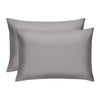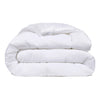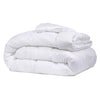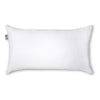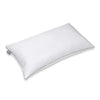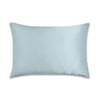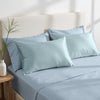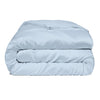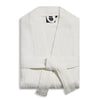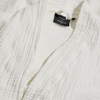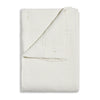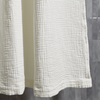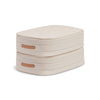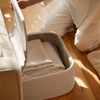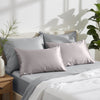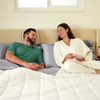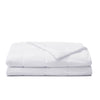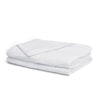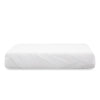The Daily Miracle
What is the Best Thread Count for Sheets?
Published
August 31, 2020
Author
Nicholas Crusie
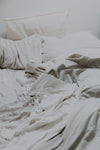
Your bed sheets play an important role in helping you get that perfect night's sleep.
You're snuggled up between your sheets for 6-10 hours a night - that's a huge chunk of your daily life. While material is usually the number one factor used for choosing sheets, you should also be paying attention to thread count.
What Even is Thread Count?
The term "thread count" gets thrown around a lot. You'll hear this term quite frequently if you've ever spoken with an employee in a home care store or even watched any of those day time television shows (you know, the ones with elegant, middle-aged women whose homes look like they're straight out of a catalog).
It's come to our attention that many of us may be simply nodding along when hearing this term but are too shy to speak up and just ask, "wait, what even is thread count?" or, "why should I care about thread count?" It's nothing to be shy about, there's no home-management class or bed linen course taught in school (although that wouldn't be too bad an idea). We're here to help.
Thread Count
Thread count is the number of threads that are woven into every square inch of fabric. For example, a sheet that has 50 threads going lengthwise and 50 threads going widthwise would create a thread count of 100. Thread count is commonly used in the bedding industry as an indicator of quality, but this isn't always the case.
What does this mean for you? Higher thread counts usually means more softness. Lower thread counts typically make a more rough or scratchy feeling sheet.
New York Magazine and Consumer Reports did some digging and found that some companies may be inflating their products' thread count by using "creative math." This ultimately misleads customers into thinking they're receiving a higher quality item than they actually are.
Thread count is to sheets as GSM (grams per square meter) is to bathroom towels.
Thread count is to sheets as carats are to diamonds.
These are important factors, but these elements aren't the be-all end-all for determining the perfect product.
When choosing bedding, other aspects to consider are material, ply, and weave.
The Ideal Thread Count Range
Thread counts in bed linen can range anywhere from 100 to 1,000+.
We recommend anywhere between 300 and 700.
A thread count below 300 will probably feel rough or scratchy, definitely not soft or silken. A thread count above 700 is likely to come with an inflated price and not much additional softness (due to probable "creative math" with achieving that higher number).
A really high thread count also indicates that the sheet is much thicker. A dense sheet will hinder air circulation, resulting in you feeling too hot while you sleep. If you're someone who perhaps sweats during the night or simply "runs hot," you may want to stay in that mid-range thread count to ensure your bed is staying breathable. Breathable sheets are super helpful for ensuring you stay cool all night long.
See what we mean when we said thread count isn't the end-all, be-all?
Home lifestyle magazine, Good Housekeeping, did a blind test on sheets made from 500 and 1,000 thread count (TC) options. Their panel of 33 testers rated each sheet exactly the same in regard to softness and feel. The only noticeable differences they found were that the 500 TC option cost $40-$100 less and that the 1,000 TC option looked less wrinkly after being washed.
What should we conclude from this? The takeaway is that aiming for a 500 thread count sheet is ideal, and a sheet around 600 would provide that extra luxe feeling without breaking the bank.
What is Multi-Ply Yarn?
Single-ply yarn is one long thread, whereas multi-ply yarn is multiple threads twisted together. The use of multi-ply yarn is what some companies use to artificially up their thread count.
A sheet made of single-ply threads, 50 lengthwise and 50 widthwise, would result in an overall thread count of 100 per square inch of fabric. If companies use multi-ply threads that are three or four threads twisted together, they could try to advertise the same sheet as having a 200, 300, or even 400 thread count. This would result in the sheet being denser without actually being a higher level of quality.
Other Elements to Look for in Towels
Material
Cotton is the most popular and widely used material for bedding. The highest end cotton available is Supima, Egyptian, and Turkish. The length of the fibers in cotton is the indicator used to measure its quality. Egyptian and Supima cotton offer the longest threads, making them the strongest options while still being fine and silky.
Supima cotton is grown right here in the United States which ensures that it goes through rigorous testing and stands up to high standards. Supima cotton tests 45% stronger and more durable than other cottons, making it a great investment to serve you night after night after night. Supima cotton is also highly breathable and luxuriously soft to touch, meaning you'll stay cool throughout the night and feel like royalty.
Look for Supima or Egyptian cotton to make sure your sheets will be the most soft, durable, and breathable.
Ply
Ply is the thickness of a sheet measured by the number of layers it has. Think about paper towels or toilet paper; many companies advertise double or triple ply because it tells the customer that the product is thicker, softer, or more absorbent.
Mulit-ply made seem appealing at first, but multi-play fabric is usually made up of simply a higher amount of lower grade threads. When lower grade threads are woven together it creates a false sense of quality and strength and will result in a rougher feeling sheet.
If you've already chosen quality material like Supima or Egyptian cotton, single ply is all you need. Quality over quantity, remember?
Weave
There are two different styles of weave: percale and sateen.
Percale is the standard one-over one-under technique. Percale is a tight and flat weave and usually results in a matte looking finish. Percale weave is great for creating a cool and crisp look. Just because it's a tight weave doesn't mean it isn't permeable; percale weave is actually extremely lightweight and breathable, meaning you'll feel and stay cool throughout the night. If you tend to feel hot while you sleep, percale weave sheets may be the best choice for you.
Sateen is a one-over three-under weave. Having this extra thread exposed on the surface is what creates an extra silky and soft feeling. Sateen sheets will also have a bit of a glossy finish to them, which makes them look and feel extra luxurious. Since sateen weave is more tightly woven and heavier in weight, it's slightly less breathable than percale. If you tend to get cold during the night, a sateen weave sheet will lay more heavily on you and help retain body warmth.
The Takeaway
The takeaway is that you should look for bedsheets with a thread count between 300 and 700.
A sheet with a higher thread count generally requires the use of finer threads. Finer threads result in a softer and smoother surface.
Thread count affects the weight, permeability, and feeling of a sheet.
Other things to keep in mind while shopping for bed sheets are the material, ply, and weave. Just like everything else in life, balance is usually the answer.
Keep these things in mind next time you're shopping for sheets and you can thank us later. Sleep tight!
 |
Did you know?If you tend to get cold during the night, a sateen weave sheet will lay more heavily on you and help retain body warmth. |
Sources:
- https://home.howstuffworks.com/home-decor/bedroom/thread-count.htm
- https://nymag.com/shopping/features/54060/
- https://www.consumerreports.org/cro/news/2013/09/higher-thread-count-doesn-t-guarantee-better-sheets/index.htm
- https://www.goodhousekeeping.com/home-products/a27494227/best-thread-counts-for-sheets/
- https://authenticity50.com/blogs/news/45263044-what-is-the-best-cotton-for-a-good-nights-sleep


